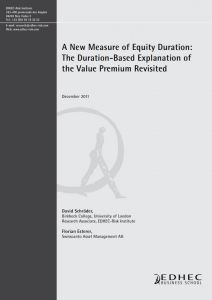

A New Measure of Equity Duration: The Duration-Based Explanation of the Value Premium Revisited
This paper proposes a new methodology to estimate a share's equity duration by using analysts' cash-flow forecasts. It finds that short duration is associated with high expected and realised returns — which cannot be attributed to the shares' systematic risk exposure as implied by the market beta. Instead, the paper shows that this measure of a company's average cash-flow maturity is a priced risk factor that has similar properties as the Fama-French factor B/M ratio. Our analysis suggests that the value premium might be a compensation for the value firms' higher exposure to cash-flow risk.
Author(s):
Summary:
This paper proposes a new methodology to estimate a share's equity duration by using analysts' cash-flow forecasts. It finds that short duration is associated with high expected and realised returns — which cannot be attributed to the shares' systematic risk exposure as implied by the market beta. Instead, the paper shows that this measure of a company's average cash-flow maturity is a priced risk factor that has similar properties as the Fama-French factor B/M ratio. Our analysis suggests that the value premium might be a compensation for the value firms' higher exposure to cash-flow risk.
Register to download PDF
Register/Log in| Type : | Working paper |
|---|---|
| Date : | 11/07/2011 |
| Keywords : |
Asset Pricing |

